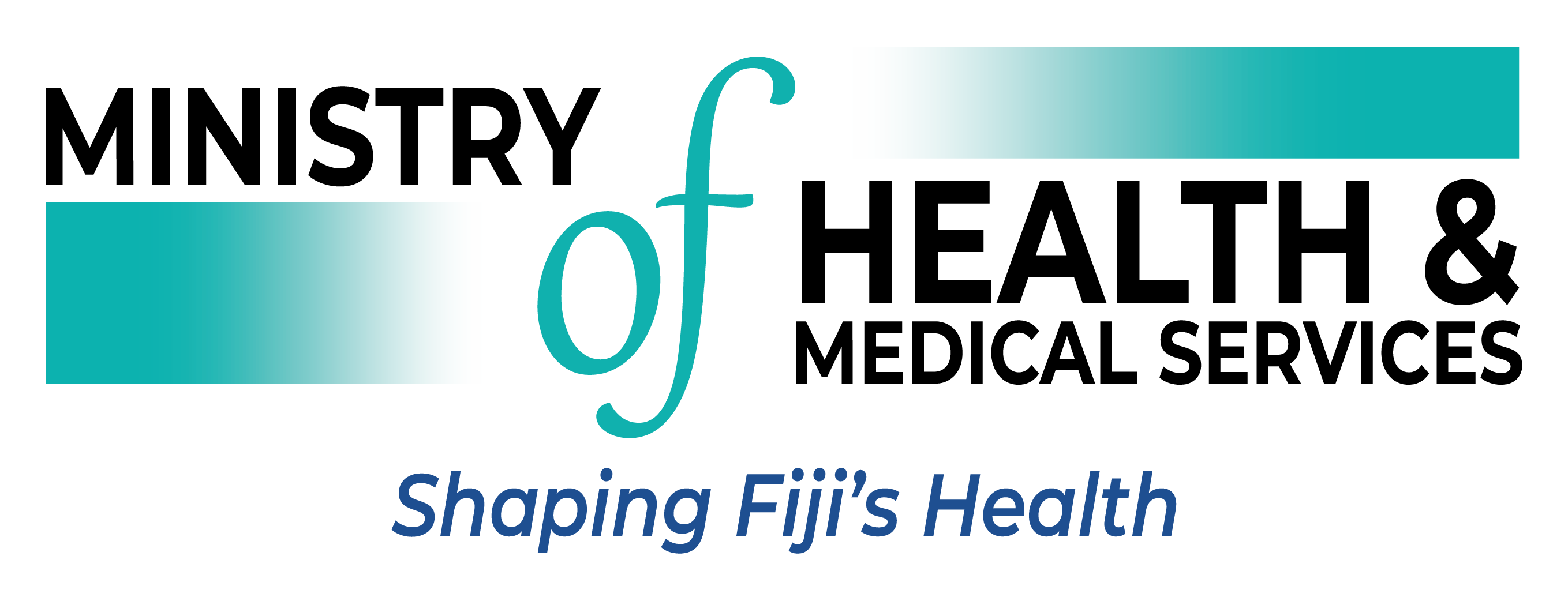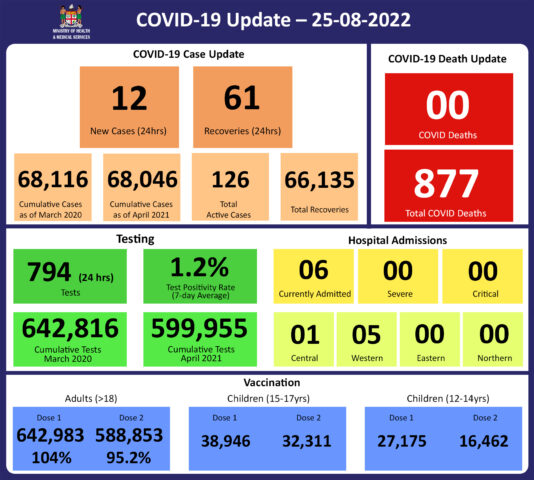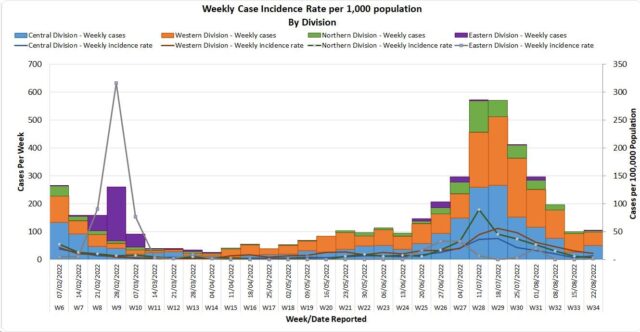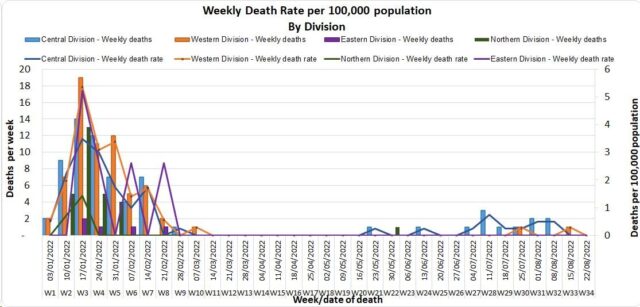COVID-19 Update 25-08-2022
COVID-19 Update
Thursday 25th August
| Transmission Update:
Since the last update, we have recorded 36 new cases of which 13 new cases were recorded on 23/08/2022; 11 new cases on 24/08/2022 and 12 new cases in the last 24 hours ending at 8 am this morning. Of the 36 cases recorded, 14 cases were recorded in the Central Division; 21 cases were recorded in the Western Division; 1 case was recorded in the Northern Division and nil case was recorded in the Eastern Division. The national 7-day rolling average of cases as of 21st August is 15 daily cases. In the 7 days until 24/08/2022, 39 new cases were recorded in the Central division, 34 new cases in the Western division, 1 new case in the Northern Division and nil new cases in the Eastern Division. The Central Division cases constitute 66% of the cumulative total cases nationally, with the Western division making up 28%, 4% in the Northern Division, and 2% in the Eastern Division. |
||||||||||||||||||||||||||||||||||||||||||||||||||||||||||||||||||||
| Deaths:
The curve depicts weekly COVID-19 deaths by division since May 2021. It indicates a surge from last December, with peaks in mid-January 2022 followed by a downward trend. The latest COVID death was reported on 12/08/2022. COVID Death Reports We have no new COVID-19 deaths to report. Analysis of COVID-91 Deaths Table 1: Death rates by Division
An analysis of the 176 deaths recorded since December 2021, shows that the Central Division has the highest absolute number of deaths, and the Northern Division has the highest rate of death when adjusted for population. Table 2: Deaths by Age Group
For the 176 deaths since December 2021, the death rate adjusted per 100,000 population, has been highest in the age group 50 years and over. There were 9 deaths below the age of 19 years, 7 out of the 9 children had significant pre-existing medical conditions, and two (2) children had no known underlying medical condition. Table 3: Deaths by Vaccination Status
Out of 176 COVID-19 deaths reported since December 2021, seven (7) deaths were in the population not eligible for vaccination (under age 12). An analysis of the 169 deaths in the vaccine-eligible population revealed that Fiji has a death rate of 11.7 per 100,000 population for fully vaccinated adults and 333.6 per 100,000 population for unvaccinated adults. This means that unvaccinated adults in Fiji have been dying at a rate 28.5 times higher than fully vaccinated adults. Individuals in the 12-17 age group who died were not vaccinated. There are three (3) individuals who recently died due to COVID-19 and had received the 3rd Booster dose. There has been a total of 877 deaths due to COVID-19 in Fiji. As of August 18th, 2022, the national 7 days rolling average for COVID-19 deaths per day is now 0.1, with a case fatality rate of 1.29%. Due to the time required by clinical teams to investigate, classify and report deaths, a 4-day interval is given to calculate the 7 days rolling average of deaths, based on the date of death, to help ensure the data collected is complete before the average is reported. We have also recorded 976 COVID-19-positive patients who died from other serious medical conditions unrelated to COVID-19; their doctors have determined that COVID-19 did not contribute to their deaths, and therefore these are not classified as COVID-19 deaths. |
||||||||||||||||||||||||||||||||||||||||||||||||||||||||||||||||||||
| Hospitalisation:
Using the WHO clinical severity classification, there are 33% (n=2) cases in the asymptomatic and mild categories; 50% (n=3) in the moderate category; 17% (n=1) in the severe category; with nil cases in the critical category. Anyone admitted to the hospital is tested before admission, therefore, a high number of people who are admitted to the hospital for non-covid health conditions, test positive for COVID-19 due to the current level of transmission in the community. |
||||||||||||||||||||||||||||||||||||||||||||||||||||||||||||||||||||
| Testing:
794 tests have been reported for August 24th, 2022. Total cumulative tests since 2020 are 642,816 tests. The 7-day daily test average is 1,281 tests per day or 1.4 tests per 1,000 population. The national 7-day average daily test positivity is 1.2%, within the WHO recommendation of 5%. |
Public Advisory
For COVID-19;
While we continue to see a persistent decrease in the reported case data, which is supported by other community-based indicators, we must continue to be vigilant and escalate community-wide adoption of COVID safe measures together with immunisation as a means to reduce disease spread and protect those in the community who are less able to fend for themselves.
The impact of immunisation is clearly demonstrated in our hospitalisation rates for severe disease which has decreased as reported by all the divisional hospitals. And we know that vaccination combined with COVID safe measures will help keep the health care load manageable. Based on the above data and reported global trends, expanding the vaccination coverage to children and increasing the uptake of booster doses will improve our ability to live with covid and ensure that we can continue to engage safely in the recovery of our economy and with the health system.
Our hospitals will continue to maintain stringent COVID safe measures which include restricting visitors and more strict enforcement of masking, and hand sanitization practices while strengthening screening protocols. This is to help minimise the risk to patients admitted for severe non-COVID ailments. For workplaces, we strongly advise that COVID safe measures be continually promoted and enforced by management.
Community and Workplace leaders are encouraged to maintain many of the COVID safe measures that the community and organisation have learnt during the acute outbreak. This will help us to live with COVID while at the same time reducing the risk of vulnerable people getting COVID and/or suffering from severe consequences.
We have maintained a number of public health mandates and measures related to vaccination and incoming travel. The Ministry of Health and Medical Services envision that the more people get vaccinated with the booster doses, the better the level of protection, and the safer it will become to remove the remaining public health measures further. For this to happen, the Ministry is currently targeting an 80% booster coverage for those over 18 years of age. We may review this threshold if current trends in cases and severe disease hold.
Anyone who is sick should not be attending work or school. If you have COVID-19 symptoms, you must get tested for COVID-19. If you test positive, isolation is mandatory for 7 days.
COVID-19 Vaccination
We have been reporting that 100% of our estimated adult population have received one dose and at least 95% have received the second dose. The vaccination of our target population has been progressing well with the 12 years and above coverage rate for Fiji being 99% for Dose 1 and 89% for Dose 2. Furthermore, as of the 22nd of August, 163,415 (52.3%) booster-eligible individuals have so far received their 3rd dose while 24,673 individuals have been administered the 4th dose.
Update on the Pediatric Pfizer Vaccination:
Further to the start of the roll-out of vaccination to the 5 to 11 years in the Central Division, the 2nd dose has commenced from the 17th August 2022 which will be administered in the same school. For the second dose administration a, signed consent is not requested.
We are also offering opportunities for schools that had missed out on their initial 1st doses.
Western Division Rollout:
The Western Division will commence rollout on Monday, 29th August 2022. However, starting today Lautoka has started with the 5-year-old vaccination. Parents are requested to ensure the Consent Cards are signed and sent to their Child’s school.
Increasing Vaccine Booster Coverage Program
We urge the public to get booster vaccine doses at the vaccination site closest to them and the list of sites is provided daily by the MHMS. Currently, both Pfizer and Moderna are recommended for booster doses.
To optimise coverage, our current target of the booster campaign is to administer 250,000 doses of Pfizer vaccine to those who have completed the primary series (doses 1 and 2) three or more months prior but have not yet received a booster dose.
COVID-19 booster priority populations are;
- Persons over the age of 18 years who have completed their primary series > 3 months prior can receive their 1st booster dose
- Immunocompromised persons and those over the age of 60 years who had received the 3rd booster dose, may receive the 4th dose after a period of 4 months
- Health care workers, port staff, tourism and others who wish to receive a 2nd booster dose may receive it after an interval of 4 months from their first booster dose.
- Anyone over 18 years who have taken their 1st booster dose can receive a 2nd booster dose after an interval of 4 months.
COVID-19 vaccination to the 5-11 years in Fiji.
Overall Plan
The Vaccination Roll was started in the Central Division on Wednesday 6th July. While we had hoped for rapid and broader deployment, the stringent cold chain logistics need further strengthening to support further deployment, to the Western Division then Northern and Eastern Divisions.
The Ministry of Health and Medical Services is committed to:
- Equitably allocating sufficient doses to vaccinate all the 132,893 children aged 5-11 in Fiji.
- Equitably track and position vaccine sites to ensure that eligible individuals can receive vaccines in a safe and timely fashion.
- Provide evidence-based, unbiased information on vaccine safety, physical distancing, and mask-wearing to maximize the impact of these vaccines.
The Fiji Action Plan for COVID-19 vaccination of children aged 5-11 is a three-fold approach to;
(1) Identify and prioritize eligible individuals and communities,
(2) Engage those individuals and communities with a targeted outreach and communication plan and,
(3) administer the vaccines to eligible children whose parents have consented..
Administration of Vaccine
The Ministry of Health and Medical Services through the 22 Sub Divisions with our School Health Teams have been leveraged to carry out the planned Vaccination rollout.
All school sites have been contacted to be vaccination sites.
The Health Facilities will also host vaccine clinics, as well as Pfizer vaccine clinics on weekends and the School Holidays.
The Sub Divisional Mobile Teams will also implement a homebound vaccination program that will be available to ensure that homebound children aged 5-11 will have access to immunizations if not available through their Schools.
Vaccine Clinics
Sites that have been identified for the administration of the Pfizer-BioNTech vaccine include;
- Current Fixed MCH clinics operated daily for those children of 5-11 years who would want to access these facilities.
- Mobile vaccine clinics for the Early Childhood Education Centres.
The School Vaccination Teams will be visiting schools this Term 2 to conduct vaccination according to the planned dates.
Other schools identified as priority community vaccination locations include the special schools that cater for children with special needs.
Opportunities may be offered to the sites hosting community events (sporting, etc.)
The Consent Process
Consent is obtained through the Consent Form of a parent or guardian for allowing their child to receive the age-approved vaccination.
The consent process includes:
Onsite consent to be provided by a parent or guardian who is physically present with the minor at the vaccine site. The parent or guardian will sign an appropriate vaccine administration Consent Form.
For Off-Site consent:
- A consent form can also be taken home by children to be signed by the parent or guardian
- A letter can also be written/typed and signed by the parent or guardian.
- The acceptance of a letter of consent shall be documented by the Vaccination Team and the letter shall be retained with the patient record.
- The presence of a support person will be accommodated at all vaccine sites
Consent and Vaccine Information Documentation:
The Consent Form includes information on demographics (name and DOB), questions asked by the parents or support person and a place for the parent/guardian’s signature. Your questions will be dealt with by the vaccine provider.
The Vaccination Card indicates approval to release identifiable information to medical providers, and a place for the vaccinator to note the date (1st and 2nd Dose), a batch number and the type of vaccine.
A vaccine information booklet accompanies the Consent forms.
Non-Covid Vaccine-Related Immunisation
Globally, WHO has expressed concern regarding falls in non-covid immunisation rates due to the pandemic. We have seen this manifest in a number of developed countries. We also expect that certain areas in Fiji have immunity gaps. In addition, we have reported suspected cases of measles (8) and rubella (2) wherein the initial tests done were positive. We have also been made aware that a number of circulating viruses can result in false positive tests for measles and rubella. Despite this, we are currently conducting preventative Supplementary Immunisation Activities throughout the nation to mitigate the potential impact of these reported cases.
Ongoing Medical Recovery Efforts
Some concerns have been raised about the ongoing exodus of medical staff. While we acknowledge that it is happening in Fiji, this is a global issue and not specific to Fiji. Many developed countries including Australia, New Zealand, and the USA have reported shortages relating to the exodus of health care workers. The key reported cause relates to underlying or imminent burnout. As such many health care workers around the world are moving to what they perceive to be greener pastures with less stressful work conditions. Many global surveys and studies attest to these global patterns. These surveys and studies also highlight the factors related to burnout such as work-life balance contribute to the stress that workers feel when dealing with their families. This drives the healthcare workers out of their workplaces.
The workforce gap created in these developed countries then provides the opportunity for many of our health care workers to move in search of new experiences. The Ministry of Health and Medical Services together with our Honorable Minister will always wish them well in their endeavours.
The Ministry continues to review and employ strategies to improve the working environment of our workforce. A survey of nurses in Lautoka and Labasa reported that the vast majority preferred the 12-hour shift because it came with more continuous days off. Nurses work for 2 or 3 days and get 3 to 4 days off at a stretch. We have since employed this staff rostering approach at appropriate locations, and continue to assess this arrangement to ensure safe working conditions for nurses and the patients they serve. There are staff shortages that entail some health workers staying long hours at work however, the recently reintroduced overtime pay and the time off in lieu conditions will help to mitigate this.
While we are dealing with the backlog in normative services related to the prolonged closure of normative functions. Clinicians have been tracking those on the backlog list for planned treatment including surgeries and other services, and we are working on improving communications in this area.
We also have reformulated a framework to better engage customer service initiatives in all health facilities and allow senior managers to institute substantive actions and provide direct oversight over implementation plans. It will also allow the Ministry’s senior executives to track progress in implementation and ensure that the annual operation plans reflect an evolving and progressive change narrative in the successive plans. These initiatives will also include the processing of internal communications to facilitate timely decision-making and action within the Ministry.
After receiving and continuing to receive a large number of drugs and consumables we are working on a nationwide deployment effort to deliver these items to all our medical facilities. A digital supply chain management platform has been launched and we expect to see improvements in the supply of consumables and medicines as a result of these initiatives.
We are also focused on carrying out infrastructure improvements more efficiently for all health facilities, and our strategy includes the setting up of divisional mobile units to supplement facility-based general servicing and maintenance capability and also work with private providers through a process for pre-qualifying contractors and suppliers for each subdivision.
Furthermore, we continue to support the government’s initiatives on greater engagement between the public health sector and the private health sector. The engagement of General Practitioners, Private Dental Practitioners, Private Medical Laboratories, and Private Ambulance providers to support our services in a public-private partnership arrangement will greatly assist our ongoing recovery efforts, and further strengthen health care services in Fiji. This is in line with the principle of private health sector engagement to complement and enhance public health sector service.
The Fiji Medical and Dental Council is assisting in ensuring better oversight in the engagement between the public and the private sector.
As our workload relating to the COVID outbreak reduces, we are now focussing more attention on our normative function which has been impacted and stalled by the COVID outbreak. This has also been experienced in many countries abroad, and it is anticipated to take a significant amount of time and effort to address. The approach to mitigating this is to facilitate universal health coverage by adding strategic private sector engagement and strengthening our digital backbone to form the basis for sustainable action plans that include quality care improvement as an important cornerstone. This requires an ongoing multi-sectoral engagement and collaboration which is currently being actively promoted with other partner Ministries, based on lessons learnt from the Pandemic.
Last Updated on 2 years by Publishing Team



